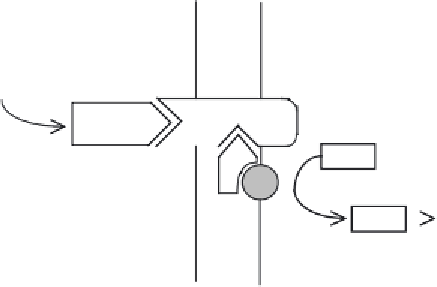Biomedical Engineering Reference
In-Depth Information
Plasma membrane
Cell cytosol
Glucagon
1
cAMP dependent
protein kinases
(less active)
2
ATP
3
cAMP
cAMP dependent
protein kinases
(active)
Metabolic
regulatory enzymes
(dephosphorylated)
Metabolic
regulatory enzymes
(phosphorylated)
Metabolic effect
Figure 11.6
Initiation of a metabolic response to the binding of glucagon to its receptor. (1) glucagon cell
surface receptor; (2) G protein; (3) adenylate cyclase. (See text for further detail)
Glucagon is also used medically as a diagnostic aid during certain radiological examinations
of the stomach and small and large intestine where decreased intestinal motility is advantageous
(the hormone has an inhibitory effect on the motility of the smooth muscle lining the walls of the
gastrointestinal tract).
Traditionally, glucagon preparations utilized therapeutically are chromatographically purifi ed
from bovine or porcine pancreatic tissue. (The structure of bovine, porcine and human glucagon is
identical, thus eliminating the possibility of direct immunological complications). Such commer-
cial preparations are generally formulated with lactose and sodium chloride and sold in freeze-
dried form. Glucagon, 0.5-1.0 units (approximately 0.5-1.0 mg freeze-dried hormone), is admin-
istered to the patient by s.c. or i.m. injection.
More recently, glucagon preparations produced via recombinant means have also become
available. 'GlucaGen' is the tradename given to one such product, produced by Novo Nordisk
using an engineered
S. cerevisiae
strain. Upstream processing (aerobic batch-fed fermentation) is
followed by an upward adjustment of media pH in order to dissolve precipitated product (glucagon
is insoluble in aqueous-based media in the pH range 3-9.5). This facilitates subsequent removal of
the yeast by centrifugation. Glucagon is then recovered and purifi ed from the media by a series of
further precipitation and high-resolution chromatographic steps. Eli Lilly also produces a recom-
binant glucagon product using an engineered
E. coli
strain.







Search WWH ::

Custom Search